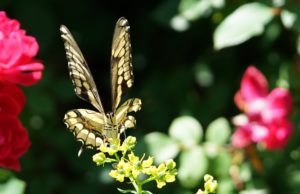Host plants for swallowtails
Views: 57225

You might be surprised by some of the plants that serve as host plants for swallowtails. My previous house had a huge, mature lilac in the front yard. Every year in early spring, Eastern tiger swallowtails visited it. Swallowtails are the superstars of butterfly world: Huge, strikingly colored, they always lift my spirits when I see them. In fact, the first butterflies I photographed were those swallowtails on my lilac bush (see photo).
Because of that association, I’ve planted four lilacs on my current property. These shrubs are still too small to produce more than a flower or two, but someday I hope they’ll be a butterfly magnet.
Other trees for tiger swallowtails
I didn’t know it back then, but common lilacs are a host plant (food source for caterpillars) for Eastern tiger swallowtails, so it wasn’t too surprising that they attracted the attention of that particular species. The females may well have been laying eggs.
Eastern tiger swallowtails will lay their eggs on other plants as well, including:
- Ash trees
- Cottonwoods
- Tulip poplars/tulip trees
- Wild black cherries
- Willows
- Other members of the Magnoliaceae and Rosaceae families.
Western tiger swallowtails look similar to their eastern counterparts. Their host plant list is very similar, but adds quaking aspen.
Other host trees for various swallowtails
As seen with the previous list, many swallowtails lay their eggs on trees and shrubs. Zebra swallowtails use pawpaw species, for example. Keep that in mind if you see caterpillars eating the leaves of your favorite tree. You might try to identify them before applying pesticides, if you like having swallowtails around. (You can take a picture of your caterpillars and submit it to the website, Butterflies and Moths of North America, and they will identify them for you.)
Here are some other trees that serve as host plants for swallowtails, although this list is not comprehensive:
- Pawpaw
- Trees in the citrus family
- Angelica trees
- Trees in the laurel family
- Buckthorn
- Coffeeberry
- Hop tree
- Magnolia
- Torchwood
- Camphor tree
The fine four
While you may not be interested in planting trees for swallowtails, a very long-term investment, fear not! It is easy to attract several swallowtail species with just four different plants:
- Dill
- Fennel
- Parsley
- Rue
I planted bronze fennel for the first time last spring, and I found black swallowtail caterpillars on it in summer.
Before planting the fennel, I tried rue in a flower bed. That same spring I saw my first giant swallowtail nectaring on garden phlox in the same bed.
It never ceases to amaze me how you can plant one plant, and the appropriate butterfly will find it. This year I am adding parsley and dill to my garden.

Giant swallowtail laying eggs on rue
Other host plants for various swallowtails
Other host plants for swallowtails include:
- Anise
- Caraway
- Carrot
- Celery
- Milkweed
- Pipevine (Dutchman’s pipe)
- Spicebush
- Sassafras
- Tarragon
- Thistle
- Queen Anne’s lace
I planted native pipevine in my yard last fall, and I’m waiting to see if it survived the winter. My soil may be a little too poor and dry for it, but I enriched the soil and planted it in a part-shade spot that’s easy to water. I planted a native species because tropical pipevines may be toxic to swallowtail caterpillars. If it survives and does well, I hope it will be discovered by a species of swallowtail I haven’t seen in my yard yet: the pipevine swallowtail. I’ll let you know if that happens.
Meet Leslie Miller
Leslie Ann Miller shares 3.5 acres in rural Oklahoma with birds, butterflies and wide variety of animals. She is currently transforming her yard with plantings…
Leslie's Recent Posts

Preparing Your Wildlife Garden for Winter






